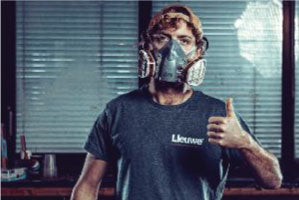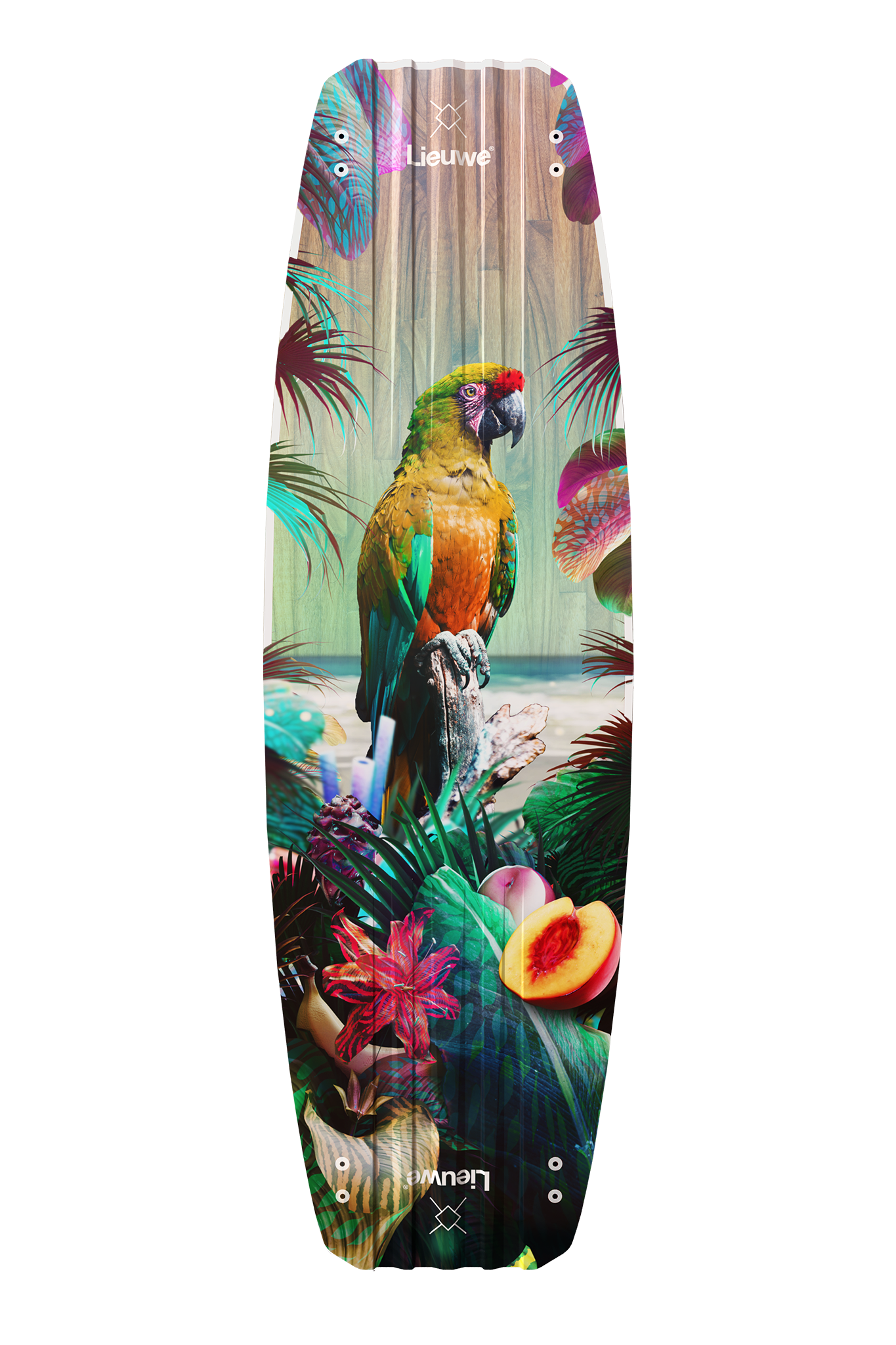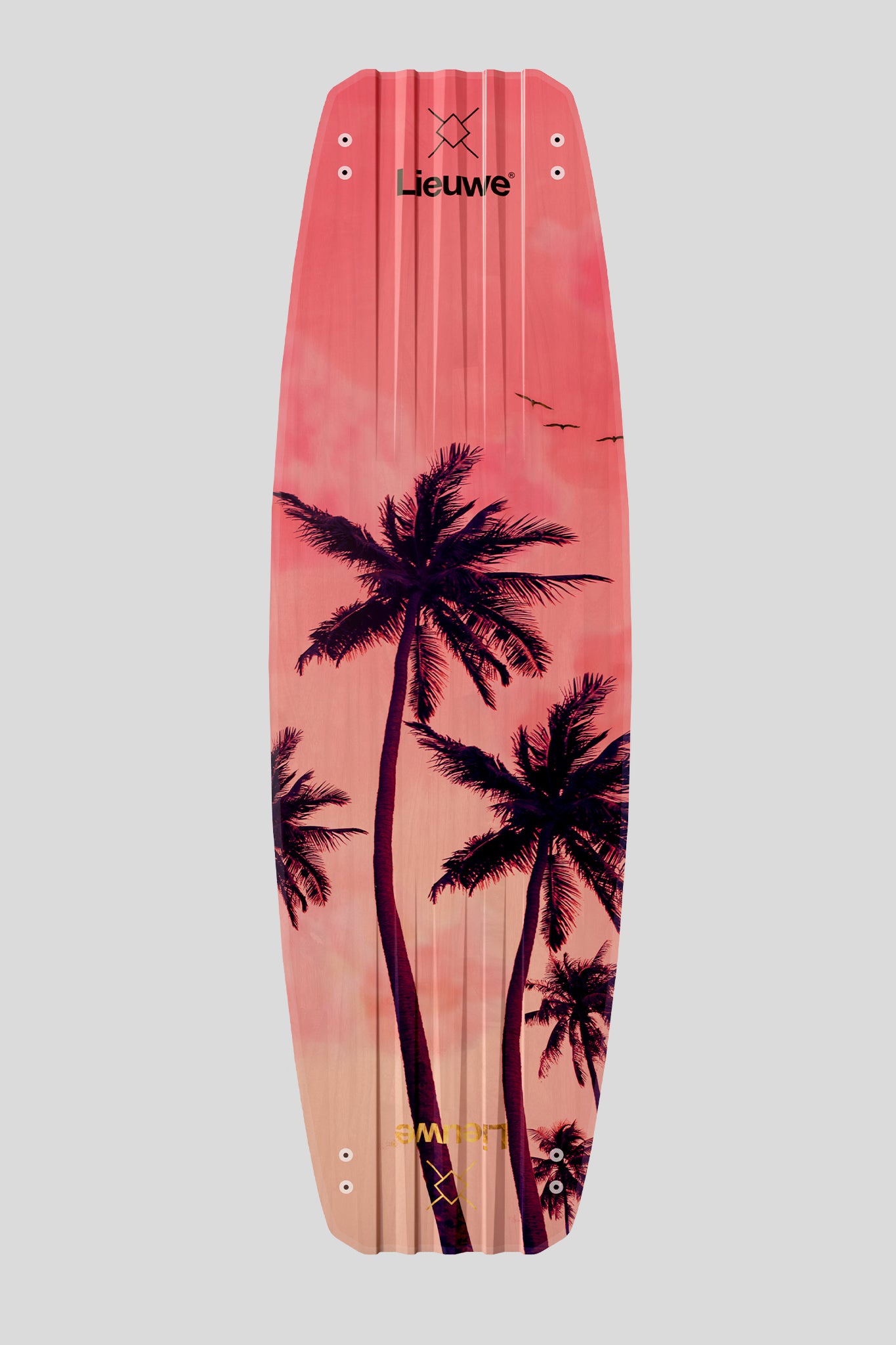The complete Kiteboard buyers guide

Everything you need to know when considering to buy a Lieuwe kiteboard.
This article is part of a series. See also our other articles, on choosing the right type of kiteboard and choosing the right size kiteboard covering a variety of alternative considerations.
Choosing the right kiteboard that suits your skills and preferred conditions is crucial. Whether you’re a beginner doubting what size kiteboard you need or a more experienced kiter wondering if a different flex and width of the board will boost your performance. We at Lieuwe started shaping kiteboards because we couldn’t find the perfect one. So, we know that it’s the sum of all specs that makes the difference. In this article you’ll find everything you need to choose the right kiteboard for you.
If you have any questions or custom requests, always feel free to chat with our shapers for personal advice.

Kiteboard categories explained
Which style do you like the most?
Your board should be the right one for you. This is why we offer a variety of board styles that help you progress at any level. Because each of our boards excels under different circumstances. Let’s start with explaining the different categories- or disciplines. Think of a freeride kiteboard, big air kiteboard, freestyle kiteboard or wakestyle kiteboard.
FREERIDE
The traditional way of kitesurfing. Cruising along, riding upwind, searching for speed, and making a nice jump along the way. The name says a lot, feeling free during the ride. When you start your first kiteboard lessons, you’ll learn the basics of freeriding. Our freeride kiteboards like the comfortable Shotgun or the beginner-friendly Awesome and the playfully high-performance Falcon are designed for stable and comfortable upwind performance in all types of conditions.
BIG AIR
this is for those who always aim higher. It’s all about the highest (over)powered airs or the biggest kiteloops possible. Big air is not for beginners, so we stacked our big air boards Oceana and Falcon full of performance and stiffness to go big and fast. With these boards you are always in perfect control, even in the most extreme conditions!.
FREESTYLE
All about the tricks. Kite loops, jumps, grabbing the board, making air. Freestyle twintip kiteboards like the Falcon, Oceana and the Shotgun are dynamic with plenty of pop and a rockered outline for smooth landings.

Kiteboard Rocker, Base Channels and Outline make the 3-dimensional shape.
All of the quiver we make are twintip kiteboards. This means there’s no distinctive nose or tail of the board. You ride these symmetrical twintips in both directions without changing your foot position. If you can’t stop admiring your kiteboard just like us, you’ll notice these three shaping elements every time you look at your board:
ROCKER
There’s no kiteboard as flat as a door (some out there can feel like one though). Kiteboard rocker is the amount of upward curving from tip to tip of the board. If you lay a kiteboard flat on the floor, you’ll easily see how much rocker is used to raise the tips up from the ground.
The more (higher) rocker a kiteboard has, the less surface touches the water when riding upor downwind. This makes the board very forgiving and easily maneuverable. You can also load the board with more pop while making airs. Ideal for freestyle and wakestyle oriented boards.
The downside of a high rocker profile is that upwind riding becomes harder, just like keeping the board at speed in light wind conditions. Kiteboards with less (lower) rocker like our Awesome and Oceana will plane faster in light wind and keep track during upwind riding because more surface of the board touches the water. It can become tricky when conditions are very choppy, brace yourself for a bumpier ride.
This makes a medium rocker profile very often used for most all-round freeride and beginner boards. Our Falcon and Shotgun boards feature such a medium profile for example. You still have the Yin of forgiving and smooth rides in choppy conditions (or while doing tricks) and the Yang of stable upwind and light wind riding.
OUTLINE
The outline of a kiteboard is simply how the two-dimensional shape of the boards looks from above. If you draw white lines around your kiteboard to mark the spot where it lies on the floor just like the FBI does on a crime scene, you exactly draw the outline of the board.
The outline can be either very curvy and rounded which makes the board clearly a lot wider in the middle compared to the tips. This rounded shape ensures very smooth and loose carving performance. It can however become too loose for stable upwind riding and too hard to control in strong wind conditions.
The other opposite is a very straight outline, so the volume of the board spreads out more towards the tips and the center of the board is less wide. This makes a stable platform, perfect for landing tricks and good upwind ability. You can also generate more pop out of a straighter shaped board.
BASE CONCAVE AND CHANNELS
Where rocker is the curvature over the length of your kiteboard, concave is the amount of curving structure in the base. Concave runs from rail to rail, in the width of the board. Adding concave to the base of the board ensures effective channeling of the water flowing underneath it. It gives the board better upwind ability, edge hold and more speed.
If you hold our boards upside down and look over the base closely from tip to tip you’ll see a mild arch running from rail to rail. The edges lie deeper than the center of the board. When riding the water underneath the board is forced through this channel and pulls the board down. The result is better carving stability, more grip and speed and faster planning in light wind conditions.
Next to the concave we also shape four ‘channels’ (quad channels) in the tips of our boards. Channels are small ridges and work together with the single concave for optimal performance. The extra channeling in the tips adds extra grip on the water and breaks the surface tension of the water for smoother landings. The enhanced grip below the tips is also great for maximising that pop for take-offs.

Kiteboard flex
Do I choose a flexible or a stiff kiteboard, which flex rate suits best?
Kiteboard flex is the ability of bending the board in all directions. The stiffer this flex becomes, the more force it takes to bend it and the faster the board will snap back in its shape when that pressure is released again. There are two bending options:
Longitudinal flex runs from tip to tip and flexes the board up and down over the length.
Torsional flex runs over the width of the board. To visualize this, imagine grabbing the kiteboard one hand at each tip and then trying to rotate those tips in opposite directions. That’s the torsional axis.
The amount of flex a kiter needs or searches all depends on the combination of his or her weight, skill level and preferred kiteboarding discipline. Starting with rider weight: that’s what builds the pressure on the board. A certain level of stiffness in a board can feel easily flexible for someone of 85 kg yet pretty hard to turn for someone of 60 kg standing on that same board.
ADVICE ON HOW STIFF YOUR KITEBOARD SHOULD BE
A beginner is better off with a soft flexing board. It’s easier to manipulate, tweak and turn when you’re still learning your balance and kite feel. This is why we give our Awesome a flexible wood core: easy entry level for all-round beginners. A soft board also absorbs the bounces over small choppy waves better, all at ease. For heavier or more experienced riders a flex that’s too soft will have more negative aspects like the lack of speed, pop, and upwind ability.
Experienced riders will always choose for a medium to stiff flex in a board. The stiffer a board is made, the snappier it gets. It takes way more power and input to flex it yet the return in pop and acceleration is also way bigger and more effective.
Our Shotgun is a medium flexed ‘jack of all trades’ for example. This board provides lots of pop while still being forgiving and it stays in control at high speeds. The Falcon is shotgun big brother on steroids: Ultra direct because of the added carbon layers to provide more stiffness, power, and control. But when the conditions get very choppy, the stiffness of Falcon demands a little bit more of your technique and fitness.
Our Oceana has a stiff flex, which isn’t for beginners. If the conditions get very choppy, the stiffness of the Oceana demands more technique and fitness. The lower amount of flex will not absorb the bounces anymore. On the other hand, stiff boards provide more power and control. You can hold down those extra knots and go even bigger than ever before!

Kiteboard construction
What makes Lieuwe boards strong and light?
Our timeless looks are the result of years of craftsmanship combining the best wood provided by mother nature and our unique fibre layer precision placement technique. The transparent layers leave zero room for imperfections, while the ultra thin layers of fibres makes Lieuwe boards one of the strongest and lightest on the market, even when compared to carbon alternatives. Our ongoing efforts to reduce our environmental footprint whilst maintaining our high-performance aspects have led us to become the world's first kite board brand that is rewarded with a Gold level certification by the Sustainable Surf foundation.

With a Lieuwe kiteboard, you’ll have a strong, ultra light, eco-friendly and timeless classic that will be your companion for life.

The best kiteboard for the local spot conditions
Which kiteboard suits the common conditions of your local spot?
Whether you prefer silky smooth flat water or you get your kicks from the ocean’s bumps and solid clean swells, spot conditions play an important role in kiteboard choice.
Flat water conditions and easily kiting upwind, match our Awesome perfectly. In search for flat or clean conditions to go fast and solid in stronger winds? The Falcon for sure is your weapon of choice.
When conditions get messy and extreme and you’re still confident to go out and charge, the Oceana won’t let you down. And when you’re that person that wants to keep all options open, our Shotgun is the most versatile, all conditions shred machine.

How do different fins affect the performance, and which do I choose?
Fins can make a big difference in your setup. You can choose the fins based on your ride preferences.
- 45MM Fins - Perfect grip for your perfect ride. More grip for upwind performance and less need for hard edging. Make sure you mount your board with the 45mm when going for the BIG AIR MEGALOOPS!
- 30MM Fins - Great for doing (wakestyle) tricks. The board will slide more across the water gives you more room to recover from bad landings and land more tricks. However, you will have less grip during riding when you are not edging. Are you ready to push your limits but you don’t want to learn it the hard way? A smaller fin size is your biggest friend when you need to work on your landing moments.

How do kiteboard bindings- or ProPads affect the performance, and which do I choose?
The Lieuwe Footpads & Straps Pro are designed to offer you the best contact with your board and enhance your board feeling. The pads are made from two types of foam to create a perfect balance between feeling with your board and comfort during landings. The heel pad and grip around your toes provide a tight fit so you never have to lose your board again. The pads and straps are assembled to one piece so putting your board together is child play and it provides an even tighter fit around your feet. We offer the ProPads specifically designed for men, women and kids.
The sizing range is recommended as follows:
|
EU |
US |
UK |
CM |
|
| Junior | 33-37 | 2,5-5,5 | 1-5 | 21-23,5 |
| Small | 37-41 | 6-9 | 4-7 | 23-25,5 |
| Universal | 41> | 8> | 6,5> | 25,5> |








Leave a comment